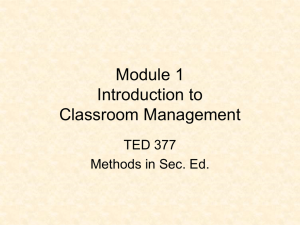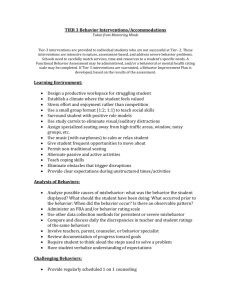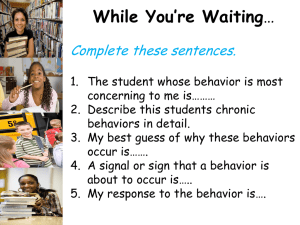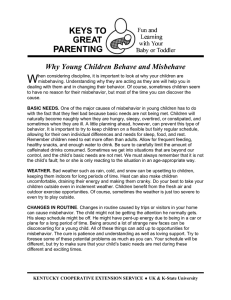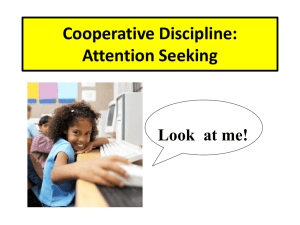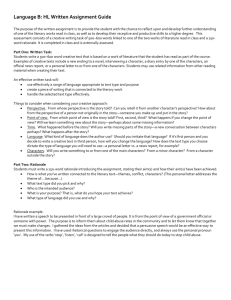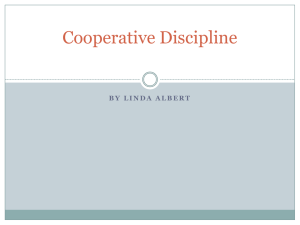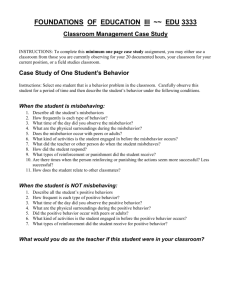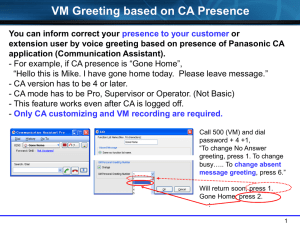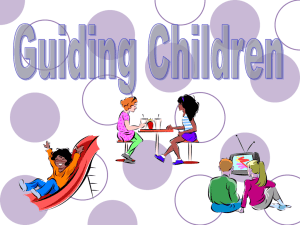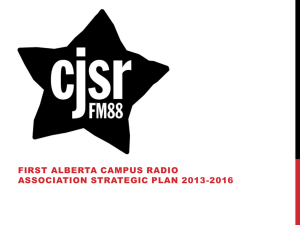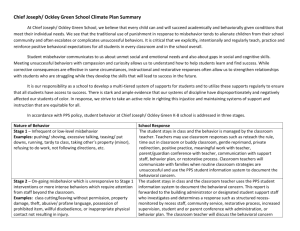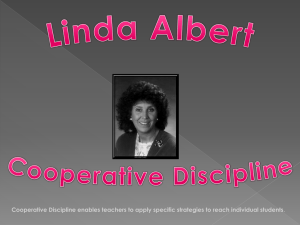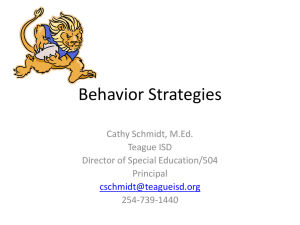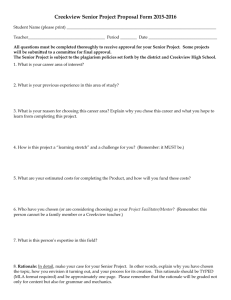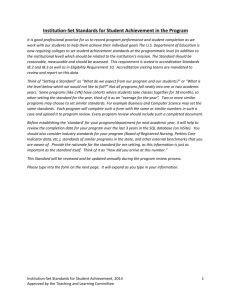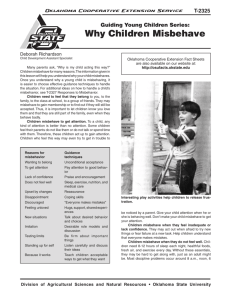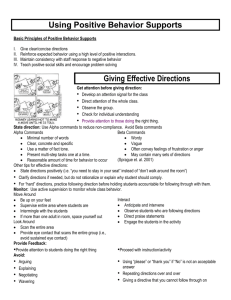Ratio of Interactions: Advanced
advertisement
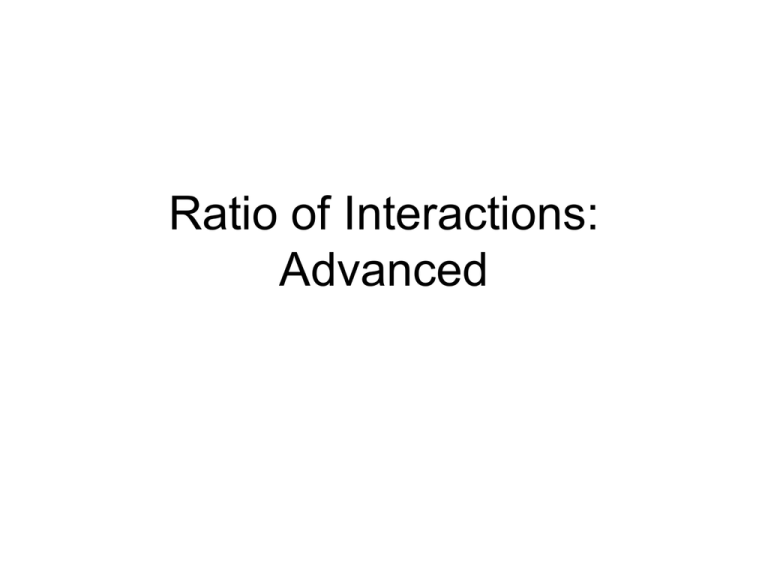
Ratio of Interactions: Advanced Ratio Of Positive Interactions • Plan to interact three times more often with each student when he or she is behaving appropriately than when he or she is misbehaving ( that is, at least a 3:1 ratio) – This strategy is essential, but difficult – Some students are starved for adult attention – For the student who is starved for attention, the form the attention takes does not matter • More satisfying due length and intensity – Behavior you pay the most attention to is the behavior you’ll get more of in the future High Ratio Of Positive Interactions • Interactions with students are considered positive or negative based on the student’s behavior at the time of the interaction • Just because an interaction is negative, doesn’t mean it is wrong. – Just be careful that you may be reinforcing misbehavior Ratio of Interactions • Foundations • CHAMP’s/Discipline in the Secondary Classroom • “Teacher attention is perhaps the most basic of all influences on student behaviors and the systematic use of attention should characterize every teacher’s classroom repertoire “ ( O’Leary and O’Leary, 1977 • “The causes of many classroom behaviors labeled and punished as rule infractions are, in fact, problems of students and teachers relating to each other interpersonally.” (Sheets and Gay, 1994) Rationale • Students enter school/classroom with a diversity of needs and backgrounds – Some have received lots of attention from adults since infancy – Others have received very little attention from adults. • Students want and need adult attention. They will engage in whatever behaviors get them the most attention Rationale • It’s easy to believe that having a classroom full of positive interactions springs from having responsible students who are exceedingly well behaved and responsible • Yet in reality….this belief is exactly backward! Rationale • In truth, positive interactions are more like the fuel that drives good behavior and personal responsibility • Unfortunately, some students with chronic misbehavior have learned it is easier and more reliable to get attention by doing things wrong than following the rules. Common Concerns About Increasing Positive Interactions • Is it appropriate to give even more time and attention to students who misbehave? – The trick is to give that student ( who is already getting your time and attention) extra attention when the student is NOT acting up Common Concerns About Increasing Positive Interactions • Do problem students deserve extra positive attention? – It isn’t a question of what students “deserve.” Teachers should already have a set of consequences when students misbehave….less positive attention shouldn’t be one of them Common Concerns About Increasing Positive Interactions • Isn’t selectively granting extra attention unfair to the other students? – Fair vs. Equal Common Concerns About Increasing Positive Interactions • Won’t the student think the positive attention is Phony? – May feel that way initially – Practice over time – If it feels weird, think about the positive interaction you have with your favorite students and attempt to match that ratio with the difficult student Common Concerns About Increasing Positive Interactions • What if You don’t like the student? – Liking or disliking a student should have nothing to do with the professional effort given to the student. – All students are given the best possible care. – Keep personal feeling separate from work. Ratios of interaction should have nothing to do with personal feelings about a student. Ratio of Interactions • How to Do THIS???? – Contingent Attention • Fluent Use of Positive Feedback – NonContingent Attention • Talking informally with students before, during and after class • Greeting students outside of school (store) • Singling out a few students each day in the cafeteria and talking to them • Being aware of things happening in the lives of students (sports, drama, choir, etc.) • Meeting students at the door and greeting them Ratio of Interactions • Marzano (2003) suggests the following: – Over the course of a class period, move toward and stand close to each student – Attribute the ownership of ideas to students who initiated them “ Dennis has just added to Mary’s idea by saying that….” – Allowing and encouraging all students to be a part of class discussions and interactions; making sure to call on students who do not commonly participate, not just students who respond most frequently. Ratio of Interactions • Tools • Increasing Positive Interactions – Self reminders – Time of day – Scan and Search • Decreasing Negative Interactions – Examine structure • Have consequences pre-planned – Precorrection strategy Sample of Consequence Planning • Talking out loud • Wandering around the room • Being disrespectful to other students • Threatening to leave the classroom • Non-verbal redirect • Proximity redirection • Time owed Restatement of the rule and referral if threat is carried out Where this fits with your Foundations Team • Safe and Civil Focus on PREVENTION 1. Defining and systematically teaching schoolwide behavioral expectations 2. Establishing a consistent system to acknowledge and reward appropriate behavior such as compliance with school rules, safe and civil interactions with peers and adults Ratio of Interactions • What can your team do to strengthen the concept of Ratio of Interactions with your entire faculty? • Discuss and Chart an idea to share with the entire group at the end of the day. • (45 minutes) Ratio of Interactions • Report out…. What might work to improve the overall Ratio of interactions with students in your school? Team Time • What activities from today ( or previous training) does your team need to work on to continue the Improvement Cycle?
